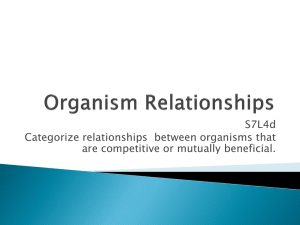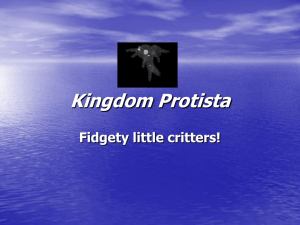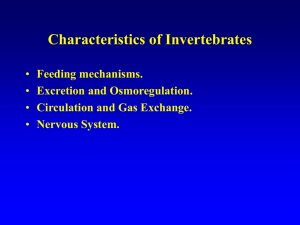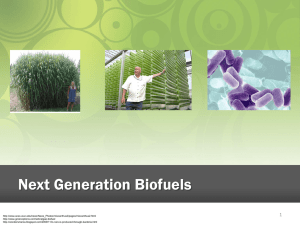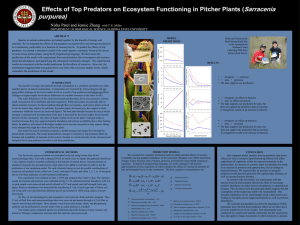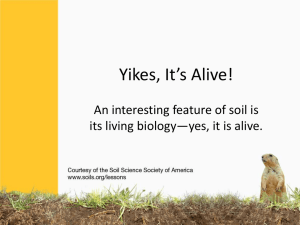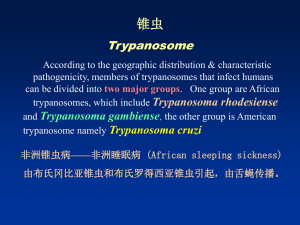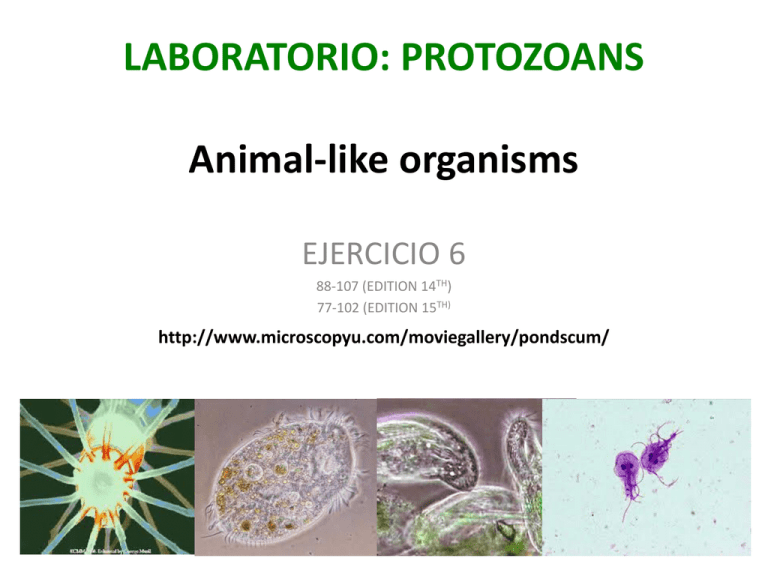
LABORATORIO: PROTOZOANS
Animal-like organisms
EJERCICIO 6
88-107 (EDITION 14TH)
77-102 (EDITION 15TH)
http://www.microscopyu.com/moviegallery/pondscum/
Goals for today
• Learn to use the microscope
• Learn to recognized the various protozoan
phyla.
• Learn their main ‘diagnostic’ characteristics
• Learn about their biology and their ecological,
economic, and medical importance
PROTOZOA
Protozoa is a polyphyletic assemblage of animal-like
organisms. This mean that many organisms grouped
under Protozoa actually evolved independently, from
different ancestors.
Hickmann et al. 2011
PROTOZOA: What they share
• Protozoan organisms have two animal like
characteristics:
– Absence of a cell wall
– Presence of at least one motile stage in the life cycle
PROTOZOA: What they don’t have
• They don’t have organs or tissues BUT have division of labor
within the cytoplasm
• Various organelles within the cytoplasm function as
skeletons, locomotory systems, sensory systems, conduction,
defense, etc.
PROTOZOA: Where can you find them?
• Protozoan organisms are found in a variety of habitats:
– Free living
• Fresh, marine, and brackish water
• Moist soils
– Parasites
– Symbiotic relationships
PROTOZOA: why are they important?
• Although protozoa are frequently overlooked, they are
ecologically very important:
–
–
–
–
As predators of algae, bacteria, and microfungi,
Herbivores
Decomposers
Parasites of great medical and economical importance
PROTOZOA: From chaos to ~order
• Previously they belong to the Phylum Protozoa where four main
groups were recognized:
–
–
–
–
Flagellates
Amebas
Spore-formers
Ciliates
• A new classification approach that considers PHYLOGENETICS
and uses MOLECULES to construct their relationships
recognizes 14 PHYLA !!!
PROTOZOA: Your Tasks
Exercise 6A:
– Phylum: Amoebozoa (naked amebas)
• Species: Amoeba proteus
PROTOZOA: Amoeba proteus
• Take a slide from your assigned box
• Look at the Ameba and try to identify the nucleus
and pseudopodia, contractile and food vacuoles.
• We don’t have any parasitic Ameba but learn
about this species: Entomoeba gingivalis, where
do you think it lives?
• Do the report AMEBA
PROTOZOA: Amebas
Amebas can be naked or
enclosed in shells:
• Ameoba proteus is a naked ameba
that lives in freshwater.
• Usually found in the underside of
water plants.
• Feed on algae, bacteria, protozoans,
rotifers, and other microorganisms.
• They are granulated in appearance
PROTOZOA: Amebas
Amebas body:
• The outer cell membrane= plasmalemma
• The plasmalemma encloses the cytoplasm:
ectoplasm & endoplasm.
Amebas Feeding habits:
• Phagocytosis: engulfing the food
• Note the food vacoules.
• Lysosomes help digestion
PROTOZOA: Amebas
Amebas locomotion:
• Amebas move and change body shape by thrusting out pseudopodia.
• Pseudopodia are extensions of the cell body.
INSERT VIDEO OF AMEBA MOVING
PROTOZOA: Amebas
Amebas excretion:
• Any undigested product is eliminated at any
point of along the plasmalemma.
Amebas osmoregulation:
• Contractile vacuole: increases in size and
then ruptures to the outside.
• This organelle rids the ameba of the excess
water taken from food or osmosis.
Amebas nucleus:
• Nucleus is disc shaped and finely
granulated.
PROTOZOA: Amebas
Amebas reproduction:
• Asexually by binary fission
Animation:
http://www.classzone.com/books/hs/ca/sc/bio_07/animated_biology/
bio_ch05_0149_ab_fission.html
PROTOZOA: Your Tasks
Exercise 6A: other Amebas
• Phylum: Foraminifera
– Marine shelled amebas
– Secrete a skeleton of 1 or more
chambers
– Skeleton: Calcareous or silica,
sand or sponge spicules
– Long delicate pseudopodia
– When died are fall to the
bottom of the ocean forming
enormous limestone deposits
PROTOZOA: Your Tasks
Exercise 6A: other Amebas
• Phylum: Radiolaria
– Marine shelled amebas
– Secrete a transparent skeleton
of silica
– Slender pseudopodia come
through the shell by pores
PROTOZOA: Your Tasks
Exercise 6B:
– Phylum: Euglenozoa
• Species: Euglena gracilis (or viridis)
PROTOZOA: Euglena
• Take a slide from your assigned box
• Look at the Euglena and try to identify the nucleus
contractile and stigma.
• Do the report Euglena
PROTOZOA: Euglena
Euglena body:
• Euglena gracilis is greenish because of
chloroplasts that contain chlorophyll.
• Body is covered by a pellicle secreted by
the ectoplasm
• The stigma or ‘eyespot’ is a reddish
pigment that is light sensitive
Euglena habitat
• Common in still pools and ponds
Euglena locomotion
• Whiplike flagellum that maybe you can
see with reduced light
PROTOZOA: Euglena
Euglena movement:
• Euglena gracilis is greenish because of
chloroplasts that contain chlorophyll.
Euglena habitat
• Common in still pools and ponds
Euglena locomotion
• Whiplike flagellum that maybe you can
see with reduced light
• Watch their movement on live
individuals
INSERVE VIDO OF EUGLENA
MOVING
PROTOZOA: Euglena
Euglena osmorregulation:
• Contractile vacuole eliminates excess of
water and waste
Euglena Feeding:
• Photosynthetic
• Carbohydrates are stored as starch
granules and paramylon (carbohydrate
similar to starch)
Euglena Reproduction
• Longitudinal fission when is free or
encysted
PROTOZOA: Your Task
Exercise 6B:
– Phylum: Euglenozoa
• Species: Trypanosoma
PROTOZOA: Trypanosoma
• Your instructor will try to find Trypanosoma. So be
patient.
• What diseases are related to this protozoan?
• Do report on Trypanosoma
INSERT VIDEO: MONSTER INSIDE OF ME: Death by Tsetse Fly
http://www.youtube.com/watch?v=4aVUrGO97Zg
PROTOZOA: Trypanosoma
Trypanosoma :
• Parasite that lives in blood or
tissues of vertebrates.
• Some species are not parasites
Trypanosoma Feeding:
• Osmotrophic= absorbs nutrients directly
from surrounding blood or body fluids
Trypanosoma diseases
• Sleeping sickness (T. brucei gambiense,
T.b. rhodesiense, T. b. brucei).
• Chagas disease (T. cruzei). Darwin was
believed to have had Chagas disease in
his trip to Chile.
Africa: Tsetse
Central and South America
“kissing bug”
PROTOZOA: Your Tasks
Exercise 6C:
– Phylum: Apicomplexa
• Species: Plasmodium
PROTOZOA: Plasmodium
• Your instructor will try to find Plasmodium in the
slide. So be patient.
• What diseases are related to this protozoan?
INSERT VIDEO: Monsters Inside Me: Malaria
http://www.youtube.com/watch?v=JwsoK8O0lXE
PROTOZOA: Plasmodium
Plasmodium:
• Causes malaria
• 300 million people gets malaria
every year.
• 3 million people die every year.
• Two hosts:
– Anopheles mosquito (female)
– Human
PROTOZOA: Apicomplexa
Plasmodium cycle:
PROTOZOA: Your Tasks
Exercise 6D:
– Phylum: Ciliophora
• Species: Paramecium
INSERT VIDEO OF PARAMECIUM
PROTOZOA: Paramecium
• Look at your Paramecium slide
• Look at live Paramecium
• Your instructor will show you a slide of
Paramecium trychocysts
PROTOZOA: Paramecium
Paramecium:
• Ciliado that inhabits fresh
water environments.
Paramecium movement:
• Very active and fast!
• Movement by ciliary action
Paramecium Body :
• Mouth=cystostome
• Body cover by a pellicle
• Two nucleus: macro & micro nucleus
INSERT VIDEO OF PARAMECIUM
MOVING
PROTOZOA: Paramecium
Paramecium osmorregulation:
• Contractile vacuole.
• Located at the end of the body
Paramecium nucleus:
• Macronucleus: regulates metabolism of
the cell
• Micronucleus: contains the animal
genome and is in charge of reproduction.
Paramecium Trychocysts:
• Is a structure under the pellicle that when
•
•
explodes releases a liquid that hardens in
water.
Believed to have a protective function.
When a paramecium feels threatened,
trychocysts shoot out from the cell
membrane like miniature arrows
Discharged trychocysts
PROTOZOA: Paramecium
Paramecium feeding:
• Holozoic= feed on
particucles e.g., bacteria
• The anal pore (cytoproct)
is located between the
mouth and the posterior
end of the body.
• The anal pore is
temporary only when
food is discharged.
http://www.youtube.com/watch
?v=l9ymaSzcsdY
Video of Paramecium feeding on
Yeast that has been stain in red
Watch the formation of food vacuoles
PROTOZOA: Paramecium
Paramecium reproduction:
• Conjugation
• Binary fission
Conjugation: oral grooves are attached
PROTOZOA: Your Tasks
Exercise 6D:
– Phylum: Ciliophora
• Species: Stentor, Vorticella
INSERT VIDEO OF STENTOR
INSERT VIDEO OF VORTICELLA
PROTOZOA: Vorticella
•
•
•
•
•
•
•
•
Solitary
Sessile ciliates
Ponds and streams
Stalk= is long ‘threat-like’
structure that attach it to the
substrate.
Body is bell shape
Peristoma contains the oral
disc.
Macronucleus is U shape
Reproduction is by binaary
fission and budding
PROTOZOA: Stentor
• Large ciliate
• Live in lakes and streams, only
one species is marine, and a
few terrestrials, some are
symbiotic with algae
• Large macronucleus that
stretch out like a string of
beads.
• Heterotrophic: is an organism
that cannot fix carbon and uses
organic carbon for growth
PROTOZOA: Experiments
Experiment
• Phototaxis
• Chemotaxis
Your instructor will place protozoans in a petri dish and under
a dissecting scope you must follow their change in
behavior :
• Noticed how they move
• Noticed their behavior when you changes of
light intensity
Important Links
http://www.savalli.us/BIO385/Diversity/01.Protozoa.html
http://www.microscopyu.com/moviegallery/pondscum/index.html
http://www.mcwdn.org/Animals/PROTOZOA.html

